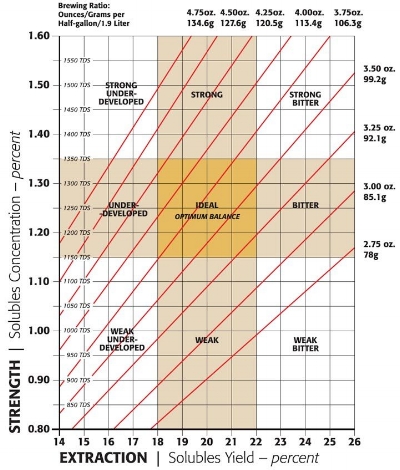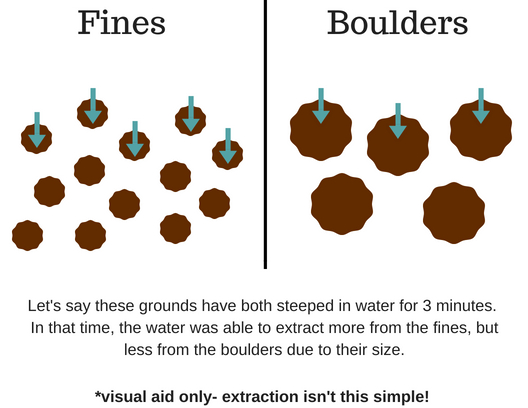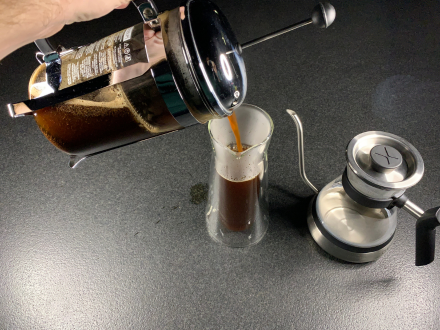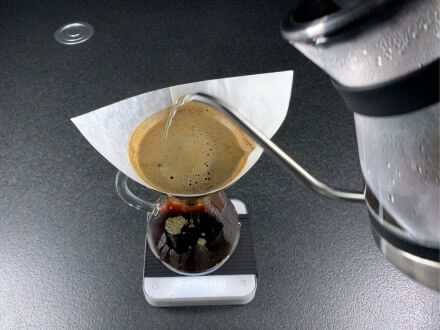June 28, 2018
How Uniform Particle Size Affects Coffee Brewing

Have you ever baked cookies or roasted vegetables but had uneven pieces? The small pieces cook fast and start to burn, while the large pieces are left raw in the middle. We can think of this analogy when we talk about grind uniformity and coffee brewing.
Defining Coffee Brewing
Brewed coffee is made up of soluble material that we extract from the roasted beans using water. A soluble can be aromatic compounds, acids, fats, melanoidins and carbohydrates. Furthermore, these all contribute to the aroma, taste and texture of coffee. In a coffee bean, there is a soluble total of 30%. The rest of the bean is made up of insoluble carbohydrates, cellulose, and general plant material which will not dissolve.

Brewing a delicious cup of coffee requires a game plan. This is because the soluble material in coffee extracts from the grounds at different rates and not all those solubles taste good. That is one reason why there are recommended grind sizes and recipes for each brewing method. It’s to help extract just the right amount. Through research dating back to the 1960s by E. E. Lockhart, extracting around 18%-22% of the soluble material from the coffee is usually ideal. We still use Lockhart’s Coffee Brewing Control Chart today as a tool to dial in brewing recipes:
What is extraction?
Extraction refers to how much soluble material was extracted from the grounds, and Strength refers to the amount of that soluble material present in the coffee sample, expressed by total dissolved solids.
Back to our cooking analogy: having uniform pieces that will cook evenly is similar to having uniform particle sizes that will extract evenly. However, because roasted coffee is brittle, it essentially fractures as it’s being ground. This causes some variance in particle sizes, resulting in some larger pieces, called boulders, and tiny coffee particles that almost look like coffee dust, called fines. The cheaper the grinder is, the more it crushes the coffee beans into random size pieces, which will cause an uneven extraction. The fines will extract faster, causing bitter flavors we associate with over-extraction. The boulders will extract slower, causing sour and sharp flavors we associate with under-extraction.

The best way to curb uneven extraction is to use a high quality burr grinder, which skillfully grinds the coffee into a more uniform particle size, reducing the amount of boulders and fines.* Many times, the grinder is overlooked, as people spend more attention on the brewing device. Let’s just say you could have the most expensive espresso machine on the market, but if you have a cheap grinder, it will be basically impossible to pull a balanced shot.
The Kruve Sifter
We wanted to experiment with how particle size affects the final beverage. For this experiment, we used the Kruve coffee sifter. The Kruve has 2 screens that separate 3 chambers. You can change the screen sizes depending on what grind size you want. The screens are a measured in microns.
First, place all your ground coffee in the top chamber. Then, shake the Kruve for 1:30 minutes. Boom! The boulders stay in the top chamber, your ideal grind size remains the second chamber, and the fines fall through to the bottom chamber.
Sifting coffee grounds to separate particle sizes already exists. However, the Kruve is the first on the market with a reasonable price tag that is intended for coffee shops and home enthusiasts. In fact, the Kruve can not only be used to create a uniform grind size but for calibrating multiple grinders. Additionally, it can find the right grind size for a brew method (they give recommendations for different brew methods!)
Coffee Brewing Experiment
For our brewing experiment, we chose a medium roast of Guatemala SHB El Injertal.**
For both brews we used a 1:16 ratio of 20g of coffee and 320g of water. We did a 25g bloom for 30 seconds, and then did a slow, continuous pour until we hit 320g. Here were the results:

The largest difference between the two brews was the sweetness and body. We tasted Brew 1 first. While we thought it was balanced, the coffee seemed to open up when we tasted Brew 2. The apple note in Brew 1 changed to candy apple in Brew 2. The dark chocolate and heavy mouthfeel in Brew 1 mellowed out in Brew 2. Overall, Brew 2 had more structured sweetness and flavor clarity.
Conclusion
By removing the fines and boulders and creating a uniform particle size, we achieved a more even extraction. This is evident by our SCA score, tasting notes, our TDS reading, and our calculated extraction percentage.***
However, we still enjoyed Brew 1. We’re sure individual coffee drinkers would have their own preferences between the two!
We will be using the Kruve more in the future, so stay tuned! If you are interested in the Kruve, then please do not hesitate to reach out to us with any questions. Email Education@royalny.com.
Lastly, we partnered with Kruve to offer our customers a 10% discount on the Sifter Six, Twelve, or Twelve + XL. Just use the code royalny at checkout: www.kruveinc.com
NOTES:
* There are deeper conversations being had about particle sizes contribution to a beverage. We are not addressing these in this blog post. This blog post is an introduction into why general uniform particle size is important for extraction.
** Guatemala SHB HHT El Injertal Rainforest certified. NJ : 101 bags, Ref#33095
***we got our TDS reading and extraction percentage by using a refractometer and VST Coffee Tools software
Left to Checkout





